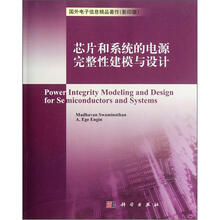芯片和系统的电源完整性建模与设计(影印版)/国外电子信息精品著作

目 录内容简介
Preface
Acknowledgments
About the Authors
Chapter 1
Basic Concepts
1.1 Introduction
1.1.1 Functioning of Transistors
1.1.2 What Are the Problems with Power Delivery?
1.1.3 Importance of Power Delivery in Microprocessors and ICs
1.1.4 Power Delivery Network
1.1.5 Transients on the Power Supply
1.2 Simple Relationships for Power Delivery
1.2.1 Core Circuits
1.2.2 I/O Circuits
1.2.3 Delay Due to SSN
1.2.4 Timing and Voltage Margin Due to SSN
1.2.5 Relationship between Capacitor and Current
1.3 Design of PDNs
1.3.1 Target Impedance
1.3.2 Impedance and Noise Voltage
1.4 Components of a PDN
1.4.1 Voltage Regulator
1.4.2 Bypass or Decoupling Capacitors
1.4.3 Package and Board Planes
1.4.4 On-Chip Power Distribution
1.4.5 PDN with Components
1.5 Analysis of PDNs
1.5.1 Single-Node Analysis
1.5.2 Distributed Analysis
1.6 Chip-Package Antiresonance: An Example
1.7 High-Frequency Measurements
1.7.1 Measurement of Impedance
1.7.2 Measurement of Self-Impedance
1.7.3 Measurement of Transfer Impedance
1.7.4 Measurement of Impedance by Completely Eliminating Probe Inductance
1.8 Signal Lines Referenced to Planes
1.8.1 Signal Lines as Transmission Lines
1.8.2 Relationship between Transmission-Line Parameters and SSN
1.8.3 Relationship between SSN and Return Path Discontinuities
1.9 PDN Modeling Methodology
1.10 Summary
Chapter 2
Modeling of Planes
2.1 Introduction
2.2 Behavior of Planes
2.2.1 Frequency Domain
2.2.2 Time Domain
2.2.3 Two-Dimensional Planes
2.3 Lumped Modeling Using Partial Inductances
2.3.1 Extracting the Inductance and Resistance Matrices
2.4 Distributed Circuit-Based Approaches
2.4.1 Modeling Using Transmission Lines
2.4.2 Transmission Matrix Method (TMM)
2.4.3 Frequency-Dependent Behavior of Unit-Cell Elements
2.4.4 Modeling of Gaps in Planes
2.5 Discretization-Based Plane Models
2.5.1 Finite-Difference Method
2.5.2 Finite-Difference Time-Domain Method
2.5.3 Finite-Element Method
2.6 Analytical Methods
2.6.1 Cavity Resonator Method
2.6.2 Network Representation of the Cavity Resonator Model
2.7 Multiple Plane Pairs
2.7.1 Coupling through the Vias
2.7.2 Coupling through the Conductors
2.7.3 Coupling through the Apertures
2.8 Summary
Chapter 3
Simultaneous Switching Noise
3.1 Introduction
3.1.1 Methods for Modeling S SN
3.2 Simple Models
3.2.1 Modeling of Output Buffers
3.3 Modeling of Transmission Lines and Planes
3.3.1 Microstrip Configuration
3.3.2 Stripline Configuration
3.3.3 Conductor-Backed Coplanar Waveguide Configuration
3.3.4 Summary of Modal Decomposition Methods
3.4 Application of Models in Time-Domain Analysis
3.4.1 Plane Bounce from Return Currents
3.4.2 Microstrip-to-Microstrip Via Transition
3.4.3 Split Planes
3.5 Application of Models in Frequency-Domain Analysis
3.5.1 Stripline between a Power and a Ground Plane
3.5.2 Microstrip-to-Stripline Via Transition
3.5.3 Reduction of Noise Coupling Using Thin Dielectrics
3.6 Extension of M-FDM to Incorporate Transmission Lines
3.6.1 Analysis of a Complex Board Design
3.7 Summary
Chapter 4
Time-Domain Simulation Methods
4.1 Introduction
4.2 Rational Function Method
4.2.1 Basic Theory
4.2.2 Interpolation Schemes
4.2.3 Properties of Rational Functions
4.2.4 Passivity Enforcement
4.2.5 Integration in a Circuit Solver
4.2.6 Disadvantages
4.3 Signal Flow Graphs
4.3.1 Causality
4.3.2 Transfer-Function Causality
4.3.3 Minimum Phase
4.3.4 Delay Extraction from Frequency Response
4.3.5 Causal SignalFlow Graphs
4.3.6 Computational Aspects in SFG
4.3.7 Fast Convolution Methods
4.3.8 Cosimulation of Signal and Power Using SFGs
4.4 Modified Nodal Analysis (MNA)
4.4.1 What Is MNA?
4.4.2 Frequency Domain
4.4.3 Time Domain
4.4.4 MNA Formulation with S-Parameters
4.5 Summary
Chapter 5
Applications
5.1 Introduction
5.2 High-Speed Servers
5.2.1 Core PDN Noise
5.2.2 I/O PDN Noise
5.2.3 Summary
5.3 High-Speed Differential Signaling
5.3.1 Test Vehicle Description
5.3.2 Plane Modeling
5.3.3 Modeling of Master and Slave Islands
5.3.4 Rational Function Modeling
5.3.5 Modal Decomposition and Noise Simulation
5.3.6 Summary
5.4 Analysis of IC Packages
5.4.1 Simulation of a Multilayered Package Using M-FDM
5.4.2 Causal Simulation of HyperBGA Package
5.4.3 Summary
5.5 Extraction of Dielectric Constant and Loss Tangent
5.5.1 Problem Definition
5.5.2 Corner-to-Comer Plane-Probing Method
5.5.3 Causal Model Development
5.5.4 Summary
5.6 Embedded Decoupling Capacitors
5.6.1 Embedded Individual Thin- or Thick-Film Capacitors
5.6.2 Why Embed Individual Capacitors
5.6.3 Design of an Embedded Thick-Film Capacitor Array
5.6.4 Integration of Embedded Capacitors into IBM Package
5.6.5 Embedded Planar Capacitors
5.6.6 Summary
5.7 Electromagnetic Bandgap (EBG) Structures
5.7.1 Basic Theory
5.7.2 Response of EBG Structures
5.7.3 Dispersion-Diagram Analysis
5.7.4 Modification of M-FDM Using Fringe and Gap Fields
5.7.5 Scalable Design of EBG Structures for Power Plane Isolation
5.7.6 Digital-RF Integration
5.7.7 ADC Load-Board Design
5.7.8 Issues with EBG Structures for Digital Systems
5.7.9 Summary
5.8 Future Challenges
Appendix A
A.1 Multiport Networks
A.2 Matrix Representation of Transmission Lines
A.3 Spectrum of Digital Signals
Appendix B Software list
Index
Acknowledgments
About the Authors
Chapter 1
Basic Concepts
1.1 Introduction
1.1.1 Functioning of Transistors
1.1.2 What Are the Problems with Power Delivery?
1.1.3 Importance of Power Delivery in Microprocessors and ICs
1.1.4 Power Delivery Network
1.1.5 Transients on the Power Supply
1.2 Simple Relationships for Power Delivery
1.2.1 Core Circuits
1.2.2 I/O Circuits
1.2.3 Delay Due to SSN
1.2.4 Timing and Voltage Margin Due to SSN
1.2.5 Relationship between Capacitor and Current
1.3 Design of PDNs
1.3.1 Target Impedance
1.3.2 Impedance and Noise Voltage
1.4 Components of a PDN
1.4.1 Voltage Regulator
1.4.2 Bypass or Decoupling Capacitors
1.4.3 Package and Board Planes
1.4.4 On-Chip Power Distribution
1.4.5 PDN with Components
1.5 Analysis of PDNs
1.5.1 Single-Node Analysis
1.5.2 Distributed Analysis
1.6 Chip-Package Antiresonance: An Example
1.7 High-Frequency Measurements
1.7.1 Measurement of Impedance
1.7.2 Measurement of Self-Impedance
1.7.3 Measurement of Transfer Impedance
1.7.4 Measurement of Impedance by Completely Eliminating Probe Inductance
1.8 Signal Lines Referenced to Planes
1.8.1 Signal Lines as Transmission Lines
1.8.2 Relationship between Transmission-Line Parameters and SSN
1.8.3 Relationship between SSN and Return Path Discontinuities
1.9 PDN Modeling Methodology
1.10 Summary
Chapter 2
Modeling of Planes
2.1 Introduction
2.2 Behavior of Planes
2.2.1 Frequency Domain
2.2.2 Time Domain
2.2.3 Two-Dimensional Planes
2.3 Lumped Modeling Using Partial Inductances
2.3.1 Extracting the Inductance and Resistance Matrices
2.4 Distributed Circuit-Based Approaches
2.4.1 Modeling Using Transmission Lines
2.4.2 Transmission Matrix Method (TMM)
2.4.3 Frequency-Dependent Behavior of Unit-Cell Elements
2.4.4 Modeling of Gaps in Planes
2.5 Discretization-Based Plane Models
2.5.1 Finite-Difference Method
2.5.2 Finite-Difference Time-Domain Method
2.5.3 Finite-Element Method
2.6 Analytical Methods
2.6.1 Cavity Resonator Method
2.6.2 Network Representation of the Cavity Resonator Model
2.7 Multiple Plane Pairs
2.7.1 Coupling through the Vias
2.7.2 Coupling through the Conductors
2.7.3 Coupling through the Apertures
2.8 Summary
Chapter 3
Simultaneous Switching Noise
3.1 Introduction
3.1.1 Methods for Modeling S SN
3.2 Simple Models
3.2.1 Modeling of Output Buffers
3.3 Modeling of Transmission Lines and Planes
3.3.1 Microstrip Configuration
3.3.2 Stripline Configuration
3.3.3 Conductor-Backed Coplanar Waveguide Configuration
3.3.4 Summary of Modal Decomposition Methods
3.4 Application of Models in Time-Domain Analysis
3.4.1 Plane Bounce from Return Currents
3.4.2 Microstrip-to-Microstrip Via Transition
3.4.3 Split Planes
3.5 Application of Models in Frequency-Domain Analysis
3.5.1 Stripline between a Power and a Ground Plane
3.5.2 Microstrip-to-Stripline Via Transition
3.5.3 Reduction of Noise Coupling Using Thin Dielectrics
3.6 Extension of M-FDM to Incorporate Transmission Lines
3.6.1 Analysis of a Complex Board Design
3.7 Summary
Chapter 4
Time-Domain Simulation Methods
4.1 Introduction
4.2 Rational Function Method
4.2.1 Basic Theory
4.2.2 Interpolation Schemes
4.2.3 Properties of Rational Functions
4.2.4 Passivity Enforcement
4.2.5 Integration in a Circuit Solver
4.2.6 Disadvantages
4.3 Signal Flow Graphs
4.3.1 Causality
4.3.2 Transfer-Function Causality
4.3.3 Minimum Phase
4.3.4 Delay Extraction from Frequency Response
4.3.5 Causal SignalFlow Graphs
4.3.6 Computational Aspects in SFG
4.3.7 Fast Convolution Methods
4.3.8 Cosimulation of Signal and Power Using SFGs
4.4 Modified Nodal Analysis (MNA)
4.4.1 What Is MNA?
4.4.2 Frequency Domain
4.4.3 Time Domain
4.4.4 MNA Formulation with S-Parameters
4.5 Summary
Chapter 5
Applications
5.1 Introduction
5.2 High-Speed Servers
5.2.1 Core PDN Noise
5.2.2 I/O PDN Noise
5.2.3 Summary
5.3 High-Speed Differential Signaling
5.3.1 Test Vehicle Description
5.3.2 Plane Modeling
5.3.3 Modeling of Master and Slave Islands
5.3.4 Rational Function Modeling
5.3.5 Modal Decomposition and Noise Simulation
5.3.6 Summary
5.4 Analysis of IC Packages
5.4.1 Simulation of a Multilayered Package Using M-FDM
5.4.2 Causal Simulation of HyperBGA Package
5.4.3 Summary
5.5 Extraction of Dielectric Constant and Loss Tangent
5.5.1 Problem Definition
5.5.2 Corner-to-Comer Plane-Probing Method
5.5.3 Causal Model Development
5.5.4 Summary
5.6 Embedded Decoupling Capacitors
5.6.1 Embedded Individual Thin- or Thick-Film Capacitors
5.6.2 Why Embed Individual Capacitors
5.6.3 Design of an Embedded Thick-Film Capacitor Array
5.6.4 Integration of Embedded Capacitors into IBM Package
5.6.5 Embedded Planar Capacitors
5.6.6 Summary
5.7 Electromagnetic Bandgap (EBG) Structures
5.7.1 Basic Theory
5.7.2 Response of EBG Structures
5.7.3 Dispersion-Diagram Analysis
5.7.4 Modification of M-FDM Using Fringe and Gap Fields
5.7.5 Scalable Design of EBG Structures for Power Plane Isolation
5.7.6 Digital-RF Integration
5.7.7 ADC Load-Board Design
5.7.8 Issues with EBG Structures for Digital Systems
5.7.9 Summary
5.8 Future Challenges
Appendix A
A.1 Multiport Networks
A.2 Matrix Representation of Transmission Lines
A.3 Spectrum of Digital Signals
Appendix B Software list
Index
目 录内容简介
《国外电子信息精品著作(影印版):芯片和系统的电源完整性建模与设计》包括电源完整性设计和建模两部分内容,重点在建模方面。全书分五章,涵盖了从基础知识到高级应用所需了解的各个细节。书中通过真实的案例分析和可下载的软件实例,描述了当今高效电源分配和噪声最小化的设计与建模的前沿技术,其中很多例子可以进行再仿真实现,这些可以用来评估常用的商用软件的准确性和速度。
《国外电子信息精品著作(影印版):芯片和系统的电源完整性建模与设计》适合研究电源完整性的学生、学者及工程师使用。
《国外电子信息精品著作(影印版):芯片和系统的电源完整性建模与设计》适合研究电源完整性的学生、学者及工程师使用。
比价列表
公众号、微信群
 缺书网
缺书网微信公众号
 扫码进群
扫码进群实时获取购书优惠





